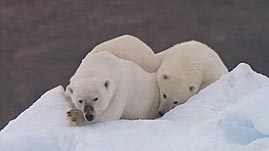Teachers' Domain - Digital Media for the Classroom and Professional Development
User: Preview

Source: National Film Board of Canada
This video segment adapted from the National Film Board of Canada examines the unique, yet fragile Arctic marine ecosystem. A scientist discusses the connections that exist in the Arctic food web, whose overall lack of diversity makes many of its members prone to extinction as change occurs in their sea ice habitat. The video explains that as global warming continues and sea ice disappears from the Arctic Ocean, new species from warmer, more southern oceans will eventually replace those species unable to adapt to the changing conditions.
Sea ice covers the Arctic Ocean, as well as much of the Bering Sea to the north and west of Alaska. Many coastal Alaska Native peoples depend on seasonal pack ice for their basic needs. So, too, do the fish, birds, and marine mammals from which people derive food and clothing. For example, polar bears traverse the ice when hunting, while walruses use it as a resting platform between feedings. Because ecosystems are founded on complex feeding relationships involving various species, disruptions to the sea ice formation caused by global warming threaten all living things in this ecosystem.
A food chain describes one possible path along which energy moves through the living things in an ecosystem—as from producer A to consumer B to consumer C. However, because most consumers have more than one food source, a more complex model called a food web is used. This shows how the various food chains in an ecosystem are connected.
Organisms both cooperate and compete within an ecosystem. The interrelationships and interdependencies that develop sustain some ecosystems for thousands of years. However, numerous factors can disrupt an ecosystem. In some cases, a new stable state is realized once species have adapted to the changed conditions. In others, however, changes in temperature, food availability, or competition can lead to ecological collapse and the death or marked decline of many species.
The Arctic marine ecosystem is highly productive. Ice algae that live on the underside of the ice pack during the winter form a thick mat come spring. Phytoplankton bloom as the water warms. These two primary food sources directly and indirectly support all other marine life, including zooplankton, fish, jellyfish, seals, birds, and whales. However, because of its extreme environmental conditions, the Arctic ecosystem lacks the diversity of most other major ecosystems. So, if the population of one predator or prey animal declines, the entire food web may be affected.
The continuing reduction in year-round sea ice in the Arctic that has been observed by Alaska Native residents is causing changes in the ecosystem. As the maximum sea ice extent recedes, new species enter the voids left by vacating species. As a new ecosystem evolves with a mix of old and new members, conditions ultimately favor those species better adapted to warmer conditions. With increased competition for resources and a loss of primary habitat, many iconic Arctic animals, such as polar bears, may ultimately disappear.
 Loading Standards
Loading Standards Teachers' Domain is proud to be a Pathways portal to the National Science Digital Library.
Teachers' Domain is proud to be a Pathways portal to the National Science Digital Library.
